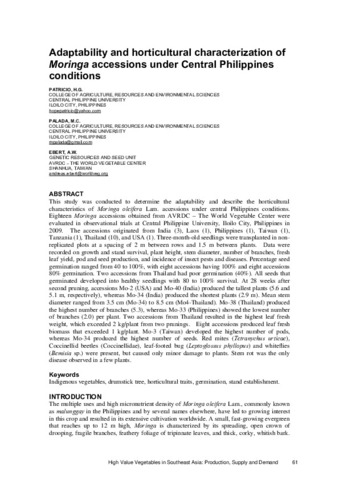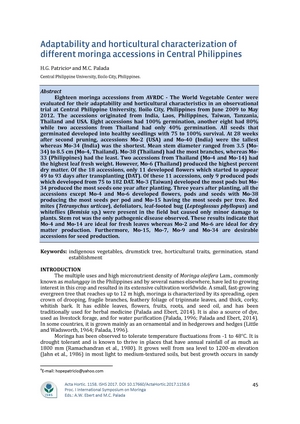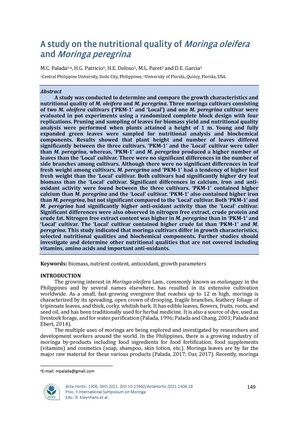Adaptability and horticultural characterization of Moringa accessions under Central Philippines conditions
Abstract
This study was conducted to determine the adaptability and describe the horticultural characteristics of Moringa oleifera Lam. accessions under central Philippines conditions. Eighteen Moringa accessions obtained from AVRDC – The World Vegetable Center were evaluated in observational trials at Central Philippine University, Iloilo City, Philippines in 2009. The accessions originated from India (3), Laos (1), Philippines (1), Taiwan (1), Tanzania (1), Thailand (10), and USA (1). Three-month-old seedlings were transplanted in nonreplicated plots at a spacing of 2 m between rows and 1.5 m between plants. Data were recorded on growth and stand survival, plant height, stem diameter, number of branches, fresh leaf yield, pod and seed production, and incidence of insect pests and diseases. Percentage seed germination ranged from 40 to 100%, with eight accessions having 100% and eight accessions 80% germination. Two accessions from Thailand had poor germination (40%). All seeds that germinated developed into healthy seedlings with 80 to 100% survival. At 28 weeks after second pruning, accessions Mo-2 (USA) and Mo-40 (India) produced the tallest plants (5.6 and 5.1 m, respectively), whereas Mo-34 (India) produced the shortest plants (2.9 m). Mean stem diameter ranged from 3.5 cm (Mo-34) to 8.5 cm (Mo4-Thailand). Mo-38 (Thailand) produced the highest number of branches (5.3), whereas Mo-33 (Philippines) showed the lowest number of branches (2.0) per plant. Two accessions from Thailand resulted in the highest leaf fresh weight, which exceeded 2 kg/plant from two prunings. Eight accessions produced leaf fresh biomass that exceeded 1 kg/plant. Mo-3 (Taiwan) developed the highest number of pods, whereas Mo-34 produced the highest number of seeds. Red mites (Tetranychus urticae), Coccinellid beetles (Coccinellidae), leaf-footed bug (Leptoglossus phyllopus) and whiteflies (Bemisia sp.) were present, but caused only minor damage to plants. Stem rot was the only disease observed in a few plants.
Paglalarawan
Conference paper
Associated Content
Download full ProceedingsMungkahing Sipi
Patricio, H. G. , Palada, M. C. , & Ebert, A. W. (2012). Adaptability and horticultural characterization of Moringa accessions under Central Philippines conditions. In Holmer, R. , Linwattana, G. , Nath, P. , & Keatinge, J. D. H. (Eds.), Proceedings of the Regional
Symposium on High Value Vegetables in Southeast Asia: Production, Supply and Demand (SEAVEG2012), 24-26 January 2012, Chiang Mai, Thailand (pp. 61-72). Tainan, Taiwan: AVRDC – The World Vegetable Center.
Uri
Conference paperISBN
9290582006Mga Paksa
Mga keyword
Serye
AVRDC Publication;12-758Collections
- Conference papers [17]
Ang mga sumusunod na mga file ng lisensya ay naiugnay sa item na ito:
Maliban kung sa kabilang banda ay nabanggit, ang lisensya ng item na ito ay inilarawan bilangAttribution 3.0 Philippines
Mga parehong item
Ipinapakita ang mga item na nauugnay sa pamagat, may-akda, tagalikha at paksa.
-
Adaptability and horticultural characterization of different moringa accessions in Central Philippines
Patricio, Hope G.; Palada, Manuel C. (International Society for Horticultural Science, 2017-05-29)Eighteen moringa accessions from AVRDC - The World Vegetable Center were evaluated for their adaptability and horticultural characteristics in an observational trial at Central Philippine University, Iloilo City, Philippines ... -
A study on the nutritional quality of Moringa oleifera and Moringa peregrina
Palada, Manuel C.; Patricio, Hope G.; Deloso, Homer E.; Paret, Mathews; Garcia, D. E. (International Society for Horticultural Science, 2021-04-15)A study was conducted to determine and compare the growth characteristics and nutritional quality of <em>M. oleifera</em> and <em>M. peregrina</em>. Three moringa cultivars consisting of two <em>M. oleifera</em> cultivars ... -
Evaluation of the efficacy of essential oil from moringa leaves (Moringa oleifera) against Staphylococcus epidermidis
Mañosa, Rhegil Joseph B. (2024-04)Staphylococcus epidermidis is a coagulase-negative and gram-positive bacterium that can cause arthritis, tendinitis, tenosynovitis, osteomyelitis and omphalitis in poultry animals. It is the most common cause of nosocomial ...








